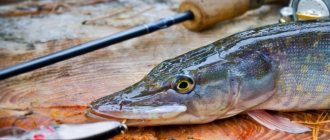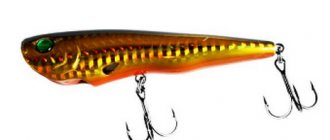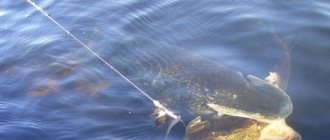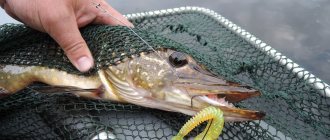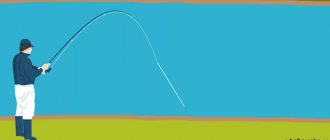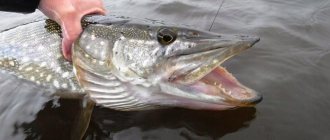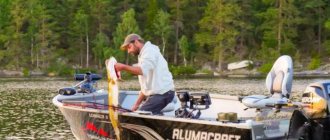How to hook a pike on a spinning rod is a pressing question that concerns both the fishing novice and the avid fisherman. Everything seems clear, tested by practice: the gear is assembled, adjusted as it should be, the baits are the most catchy, the toothy predator actively grabs the prey. Hooking, fishing, gathering... Maybe something was done wrong? And how to properly hook a pike on a spinning rod? Rumination, doubt, frustration. This situation is familiar to fans of spinning fishing.
The main mistakes of a spinning player
Having taken spinning fishing seriously, many fans of this type of fishing repeat basic mistakes.
- The fisherman does not hook at all, but begins to wind in the fishing line with a reel, rather leisurely. This action, according to experienced specialists, is erroneous (although sometimes the fish can “self-hatch”). It is traditionally believed that a bite must be followed by a hook, otherwise the predator may gently release the bait.
- In the second common case, the cutting occurs with immeasurable force. The spinner experiences joy from the bite and tugs. This also should not be done, since not every fish lip can withstand a jerk (for example, perch has rather soft lips). The hook, not yet hooked, can fly out of the mouth of the intended prey under the influence of a disproportionate hook.
- How to hook fish on a spinning rod? Both belated and premature hooking are unacceptable: hooking predators of rivers and lakes must be done on time (flair comes with experience).
Guides when fishing for pike using a spinning rod
There are different fishing options for pike, which are selected according to the type of reservoir, season, and location of the fish.
1. American. After casting, the bait should sink to the bottom. After this, they pull it two or three times with a rod 15-20 centimeters towards you and pause, reeling in the slack line. The length of the pulls and the size of the pauses may vary depending on the presence or absence of bites.
2. Stepped. When the bait falls into the bottom layers of water, the reel makes two or three turns and sends the bait to the bottom again. The optimal rhythm of its movement is selected based on the condition and behavior of the fish.
3. Aggressive. The bait is thrown to the bottom and abruptly lifted from it by 20-30 centimeters with an upward jerk of the spinning rod. Then the rod is lowered along with the simultaneous rewinding of the slack line. This wiring can be used in the complete absence of bites. The pike wakes up and attacks the bait during pauses.
4. To be demolished. The technique is suitable for fishing on fast rivers. It is similar to the American version, but in pauses between pulls the bait is released with the flow. In this case, twisters and silicone worms are the best option. They quickly attract the attention of a toothy predator.
5. Uniform. This is a complex type of wiring that requires certain skills. The bait is lowered into the water column several meters and driven, evenly reeling in the reel with regular pauses. During these pauses, the nozzle should move downwards, and at the beginning of winding - up.
The perfect strike on a predator
Several conditions are necessary for proper hooking.
- The tip of the rod is important. For fish with soft mouths, it is better to use a sensitive soft tip. It will allow you to cut the desired calculated force. Pike, whose mouth cavity is quite strong, is not afraid of brute force. You should choose a stiffer whip. By the way, pike perch also have hard lips; they often go near the shore for this reason.
- Hook at the right time, with the right force, trying to avoid the mistakes described in the previous subheading.
Pulling out of the water using additional means
Athletes and experienced fishermen often take prey in jerks. Beginners to the fishing community are advised to catch predatory fish using available means. Common and popular additional tools today include:
Let's look at how to use these means.
How to catch a pike with a landing net
It is necessary to learn the basic rule of how to pull out a pike with a landing net. Bring your prey into the landing net with the rod, and not vice versa. Remember that a landing net is not a butterfly net; work with a “stick”. Any fisherman should have this effective tool. With the help of a landing net you can catch almost any fish without harming it. But they also take pike with their hands. Read below to see how this is done.
How to pick up a pike with your hands
You can select prey with your bare hands after it has become exhausted and has stopped resisting. Often the predator senses the proximity of the shore and fights for its life with redoubled energy. If you grip incorrectly, you can injure the fish and damage expensive equipment.
It is considered the safest to grab the pike by the gills. It is not recommended to place your fingers under the gill covers. There is a high probability of cutting yourself on them. To avoid injuring the fish, do not grab it by the eyes with two fingers and put pressure on them. After such a “procedure,” the unfortunate patient has no chance of survival, and thus it is difficult to restrain the predator.
How to take linden for flu
In fishing stores or local markets you can find many devices for controlling and effectively catching predatory fish. Unfortunately, many of them do not meet modern requirements for safe trophy lifting. But a lip grip does not fall into the category of useless accessories. With the help of a fashionable aid, the fish is easily removed from the water. At the same time, there is no injury, which is important. They are simply a pleasure to work with. The clamp is applied to the pike's lip, and it migrates into the strong arms of the happy fisherman. Experts advise looking at how it works on the Internet before purchasing a clamp.
Using a gaff
Beginners can work with a hook. It will be especially useful for winter fishing. It is almost impossible to get a pike out of a hole any other way.
Finally
Catching pike with a spinning rod is a pleasure. To get positive emotions from fighting a predator, you need to know and follow certain rules: hook it in time, control the tension of the cord and fish for the trophy correctly. And also, go out on the water more often (if possible). After all, only practical experience gives you a chance to cope with an obstinate and strong opponent like the pike, good luck!
Sources:
https://zen.yandex.ru/media/id/5c57ab8bea64bc00ac1eb81b/5ca2cba3d92e0900b4479854 https://zen.yandex.ru/media/id/5c57ab8bea64bc00ac1eb81b/5ccc7f717e88ed00b4f1109e https://iarybak.ru/sh huka/kak-podsekat-na- spinning
Correct fishing for pike
It’s not enough to know how to properly hook a pike on a spinning rod; having carried out the optimal hooking, you need to get the fish out as efficiently as possible. Basic skills in fighting cold-blooded predators are required. By learning them, you can avoid getting off the hook. Other nuances will come with practice in spinning fishing.
- Do not allow the line to sag. Give some relief and the loot will go away. The pike is not hooked tightly enough and may try to free itself.
- When removing large fish from the water, use a drag - a special reel mechanism designed to release the line when the tension is too high. It allows the tackle not to sag, and when the pike jerks strongly, it does not allow it to break the tackle.
- Do not let the pike go into snags and shelters; try to take the fish out of the comfort zone, closer to the surface. Don’t let her bring the line into the shelter, where she can tear it off and not get the fish.
- Do not forget about the necessary invention of mankind - the landing net. To catch pike with a spinning rod you need a fairly durable one: the fish is strong and powerful. If there is no landing net, bring the toothy one closer and grab the base of the head, gills, and gill covers with your hand. Do not throw the fish ashore by jerking the fishing line: the tackle may suddenly break, and the desired prey will escape at the very last moment.
- Remember: the best method of gaining experience is practice. The more often you go spinning fishing, the better you can learn how to hook and fish.
Big pike rarely show their true strength until they are close to the angler. Therefore, not very experienced fishermen are surprised by the powerful and completely unexpected explosions of muscular energy of a large pike at the final stage of the fight, as a result of which the loss of fish is possible.
If the friction brake is not adjusted correctly, then only a few final jerks are enough for the poorly hooked pike to regain its freedom. And it also happens that the fishing line breaks.
Therefore, use a good rule: before fishing, thoroughly tire the pike. During the fight and especially at its final stage, be prepared to instantly lower the rod tip or loosen the friction brake. On all modern reels, you can quickly release the brake by turning the adjusting knob back a few clicks. This method allows you to instantly respond to a pike’s jerk, sometimes almost next to the boat.
Near the boat, a large pike often tries to go straight under the boat, making a powerful jerk. You need to be prepared for this and lower the end of the spinning rod into the water, raising the handle with the reel up, otherwise you will simply break it. If a motor is installed on the boat, then when fishing for a large pike, it is also advisable to lift it out of the water. It is not uncommon for a pike to wind a fishing line around a motor propeller.
Another very important detail: you should never allow the fishing line to become slack. If the pike is swimming directly at you, quickly reel in the line, holding the spinning rod at an angle, until you feel contact between the fish and the spinning rod. In addition to constant pressure on the fish, the spinning rod should spring back when throwing and other movements of the pike. With a loose line, not only contact is lost, but also control over it. In addition, the hook can come off if it stretches the hole it made in the thin lower jaw, especially during a rough and prolonged fight with a large fish. In the worst case, the hole may be so large that the hook will simply fall out of it if the pike shakes its head and the line tension and spinning rod pressure are insufficient.
Before fishing, properly tire the shuka. A large individual always has a reserve of strength, even if it seems exhausted and pacified.
To make the most effective use of the spinning rod's elasticity, you need to hold it at approximately a 90-degree angle with respect to the line - and the fish. Then the pressure on the fish will be the strongest, and it will get exhausted faster. Small pikes can be simply reeled in by rotating the reel, but larger ones should be “pumped out”. To do this, you need to raise the rod tip, quickly lower it and reel in the free line, then repeat these steps again and again.
You shouldn’t force the fight either: let the pike get tired. With the help of a relatively freely set friction brake, the pike can be allowed to rush and thus tire itself out. Only in thickets of reeds and where there are flooded trees and other debris, the pike must be taken quickly and decisively, since there is a danger that it will entangle the fishing line in vegetation or snags. Pike stuck in this way often unhook and move away.
Anyone fishing from an anchored boat must also beware of the anchor cable. I know from personal experience that it takes skill and a lot of luck to remove a pike that is wrapped around an anchor line. There is also a risk of it getting caught on the propeller, so you should always be ready to quickly raise the outboard motor if the pike's actions become difficult to control near the boat.
In the next article, let's look at how to pull a pike out of the water. At this stage of fishing, many mistakes also occur, which leads to the disappearance of fish.
| The originality of the text is certified by Yandex 10/14/13 |
Tips for beginner pikepers
Many new spinning fishermen dream of trophy pike specimens. To get them, you need to follow a few simple rules.
- You need to fish out the giant fish carefully. Do not make strong jerks. Don't give in any slack. The fish will feel it - it can get away. Don’t let her get bored on the hook, keep her at work, “on a leash,” tiring her as much as possible. Soon the fish will get tired, bring it to the shore, the boat and take it out with an appropriately sized and durable landing net. Don't let the line in, the tackle remains taut - otherwise the fish will turn around.
- There is no landing net or it is too small (such things can often happen to beginners), move the pike into the boat by hand. Do not pick up a large pike by the eyes: the brow ridges may break under the weight, causing injury to your fingers. Grab it in a place behind the head, pull it out with a strong, quick movement, throwing it into the boat. Do not let your hand slip.
- In a boat, pike, especially large ones, can be violent and cause heat. Don't leave her unattended.
If you decide to take prey, do not put it alive in a bag: it will flutter and make noise for a long time. Show respect to the trophy. Put to sleep with precise knife blows to the spine behind the head.
How to choose a place and time for successful pike fishing
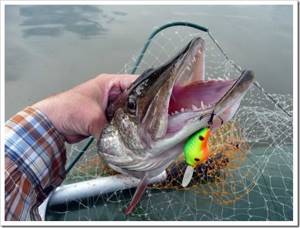
It is known that pike do not move constantly, like many other fish species. This predator chooses some kind of shelter and stands still, motionless, waiting for its prey.
Only after some time does it change place in order to again camouflage itself among snags or plant leaves.
If the fishing location is supposed to be a lake, and reeds grow along the shores, the best way is to move the bait along the reeds. On many lakes, the coastal part of the reservoir is overgrown with lily or yellow capsule. The leaves of the egg capsule are large and provide ideal shelter for pike.
On such reservoirs, it is usually useless to look for our predator in other places and throw bait deep into the lake. Pike, both large and smaller, hides precisely under the leaves of this plant and is located in the upper layer of water.
When fishing on rivers, choose places with little current. Ideal options are steep banks with sunken snags and vegetation.
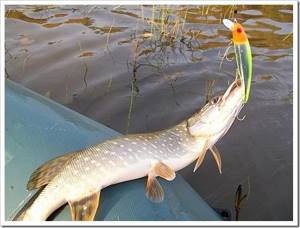
If the banks are steep, then, walking along the river and observing the water column from above, you can see a pike standing near a sunken tree and patiently waiting for prey, tirelessly wagging its tail.
You should not look for our predator in “beach areas” with a clean sandy and pebble bottom. If you find a pike there, it will be rather an exception.
Also, the exception is the places where the pit begins. At the very beginning, facing the current, our predator often stands. The boundary of shallow water with a hole is a very good place for catching pike in rivers.
The best time to hunt for pike is traditionally autumn, when the predator gains weight for the winter. But throughout the summer, young animals weighing up to one kilogram, which are actively growing and need food, take the bait well.
Regular “pike fishermen” notice that during the summer the specimens become larger each time.
In clear sunny weather in summer, pike are not particularly active, although sometimes they take bait. When weather conditions are unfavorable for us, her whim suddenly disappears, and she actively takes any bait that floats past her.
Unfavorable weather means light, prolonged rain with wind, and in the fall – rain and snow.
